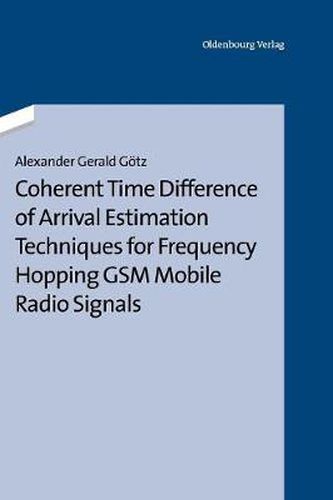Readings Newsletter
Become a Readings Member to make your shopping experience even easier.
Sign in or sign up for free!
You’re not far away from qualifying for FREE standard shipping within Australia
You’ve qualified for FREE standard shipping within Australia
The cart is loading…






This title is printed to order. This book may have been self-published. If so, we cannot guarantee the quality of the content. In the main most books will have gone through the editing process however some may not. We therefore suggest that you be aware of this before ordering this book. If in doubt check either the author or publisher’s details as we are unable to accept any returns unless they are faulty. Please contact us if you have any questions.
In this work, coherent techniques for time difference of arrival estimation for frequency hopping GSM signals are introduced. The techniques provide significant improvements in accuracy compared to state-of-the-art techniques and are ideally suited for highly accurate localization of GSM mobile phones. The key inventive concept is based on the interpretation of a frequency hopping GSM signal as a wideband signal. Thus, the applicable bandwidth for time difference of arrival estimation can be increased from 200 kHz for the narrowband burst signal to the full uplink bandwidth of the corresponding GSM standard. For E-GSM 900 systems, up to 35 MHz of bandwidth can be employed. Consequently, a localization accuracy in the scale of 5 - 10m is achievable. The presented coherent techniques for time difference of arrival estimation permit novel applications with increased accuracy requirements such as highly accurate localization in search and rescue scenarios. Furthermore, the coherent estimation concept can also be adapted to any frequency hopping signal source such as TETRA, DECT, IEEE 802.15.4 (ZigBee) and IEEE 802.15.1 (Bluetooth) devices.
$9.00 standard shipping within Australia
FREE standard shipping within Australia for orders over $100.00
Express & International shipping calculated at checkout
This title is printed to order. This book may have been self-published. If so, we cannot guarantee the quality of the content. In the main most books will have gone through the editing process however some may not. We therefore suggest that you be aware of this before ordering this book. If in doubt check either the author or publisher’s details as we are unable to accept any returns unless they are faulty. Please contact us if you have any questions.
In this work, coherent techniques for time difference of arrival estimation for frequency hopping GSM signals are introduced. The techniques provide significant improvements in accuracy compared to state-of-the-art techniques and are ideally suited for highly accurate localization of GSM mobile phones. The key inventive concept is based on the interpretation of a frequency hopping GSM signal as a wideband signal. Thus, the applicable bandwidth for time difference of arrival estimation can be increased from 200 kHz for the narrowband burst signal to the full uplink bandwidth of the corresponding GSM standard. For E-GSM 900 systems, up to 35 MHz of bandwidth can be employed. Consequently, a localization accuracy in the scale of 5 - 10m is achievable. The presented coherent techniques for time difference of arrival estimation permit novel applications with increased accuracy requirements such as highly accurate localization in search and rescue scenarios. Furthermore, the coherent estimation concept can also be adapted to any frequency hopping signal source such as TETRA, DECT, IEEE 802.15.4 (ZigBee) and IEEE 802.15.1 (Bluetooth) devices.